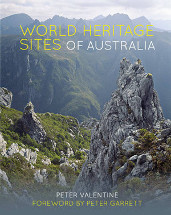World Heritage Sites of Australia by Peter Valentine

National Library of Australia Publishing, 2019. ISBN: 9780642279422.
(Age: 14+) Recommended. This large format reference book contains
comprehensive information and beautiful photographs about
Australia's unique World Heritage sites. An introduction is provided
by former Environment Minister and musician, Peter Garrett, and the
first chapter provides background information about the 1970s
development of the International Union for the Conservation of
Nature and the Convention that underpins the World Heritage
Committee's ten natural and cultural criteria used for the inclusion
and exclusion of properties of great interest, importance or value.
Sites include: Kakadu, Great Barrier Reef, Willandra Lakes, Lord
Howe Islands,Tasmanian Wilderness, Gondwana Rainforests, Uluru-Kata
Tjuta National Park, Wet Tropics of Queensland, Shark Bay (WA),
Fraser Island (K'gari), Australian Fossil Mammal Sites, Macquarie
Island, Heard and McDonald Islands, Greater Blue Mountains,
Purnululu National Park (WA), Royal Exhibition Building and Carlton
Gardens, Sydney Opera House, Australian Convict Sites and Ningaloo
Coast.
Peter Valentine, a professional geographer, provides an informative
account of each of Australia's 19 sites, beginning with the listing
of Kakadu National Park in 1981. Kakadu, was an excellent choice as
Australia's first mixed cultural and natural choice as a World
Heritage site. It has 50,000 years of Indigenous occupation,
wonderful x-ray and handprint cave paintings, sandstone escarpment
of the Arnhem Plateau, tropical savanna woodlands and floodplains,
exotic birds and reptiles. The author also highlights threats such
as mining, introduced species, climate change and the management of
annual visitors numbering around 200,000.
Each World Heritage site is described with a location map, whole
page photographs, a short introduction, a personal impression, and a
history of the 'path to world heritage'.
Students of environmental studies or geography in middle and senior
high school would find plenty of useful information about the
qualities and management of each property. The 293 page book
includes a useful index.
The concluding chapter of the book highlights the future of world
heritage in Australia, which includes not only the role of UNESCO or
the Australian Government but also the role of local communities
being more involved, particularly in the light of increasing recent
threats from climate change and invasive species.
Paul Pledger